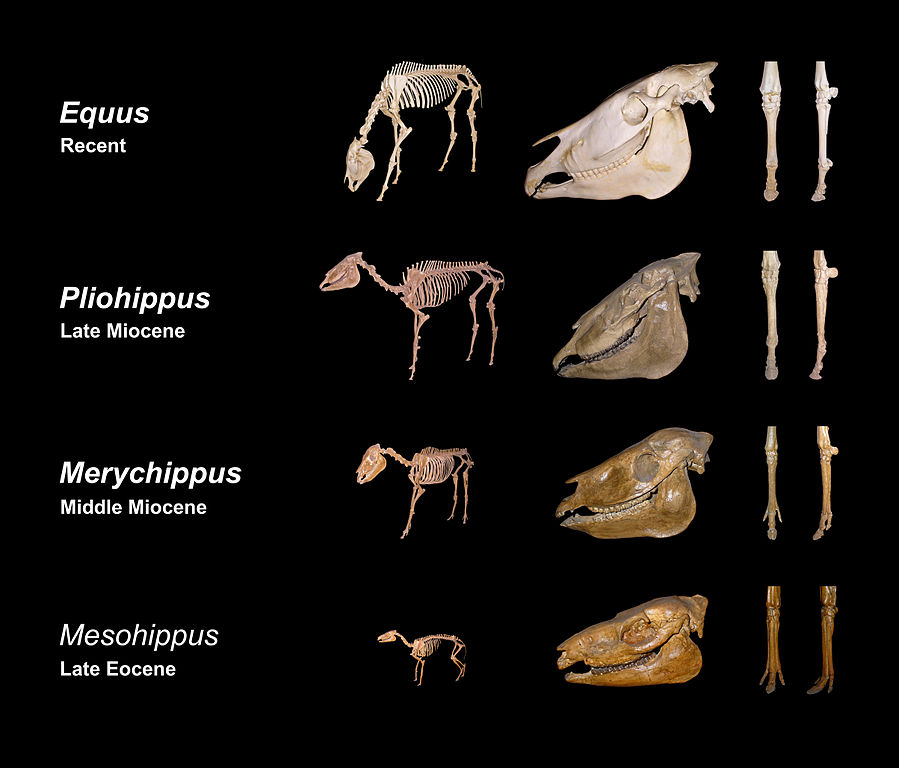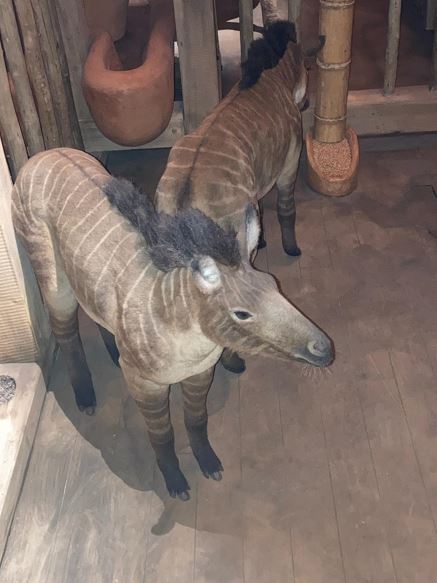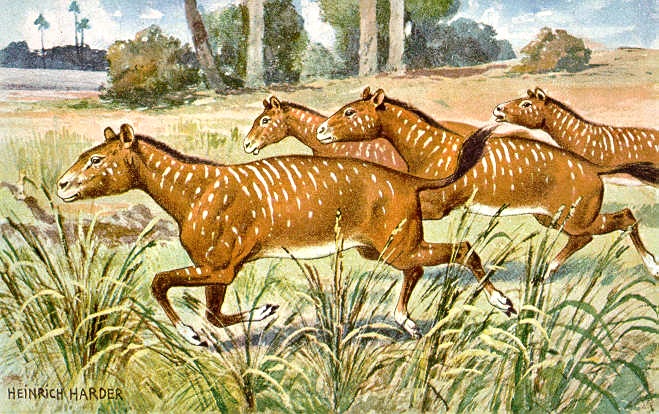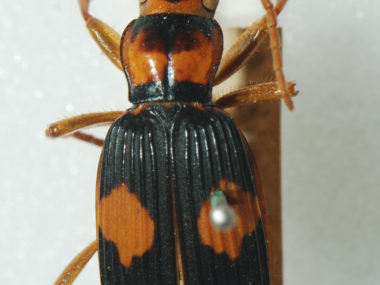There is currently disagreement within the creationist community as to the diversification of the horse. Some creationists insist that much evidence exists supporting the evolution of the horse from the dog-sized Hyracotherium through to our modern horse, Equus.1 Other creationists disagree, proposing instead at least three separate created kinds.2 Those advocating for a “middle-ground,” tentatively advocate an “evolutionary” sequence starting at Mesohippus.3
The following article has been reblogged with permission from Creation Unfolding. The views expressed in this article reflect those of the author, and not necessarily those of New Creation.
What are Christians to make of these conflicting opinions? Those that espouse a very conservative position (multiple created kinds) must “at least” admit that horses had three toes on each foot. Even Molén4 acknowledges that Merychippus and Pliohippus are to be included with Equus as a single created kind. Yet Merychippus had three toes. Fossils of Pliohippus have been found with a single toe, but some also have three toes.
Even modern horses have been known to “grow” extra toes. This is not a congenital malformation as when babies are sometimes born with a sixth finger. In horses, the extra toes grow from the two splint-bones on either side of the main toe (hoof). Sometimes these toes appear with a full set of carpal or tarsal bones, and sometimes are even found with a partial fourth toe!
Paleontologists as far back as the late 1800s had already studied many of these living polydactyl horses. Othniel Charles Marsh says this of the carpal bones and toes in one of these horses: “The presence of four toes in the fore feet, each supported by its true carpal bone, is a fact of much importance, and is clearly a case of reversion.”4 By “reversion” Marsh is suggesting that these toes are not congenital deformities, but rather a “reversion” to a more “primitive” state.
That a general sequence exists within the fossil horse series is obvious from the figure below. Going up the sequence, notice: 1. A reduction in toes, 2. The development of more complex teeth, and 3. The migration of the eye from over the teeth to behind the teeth. Other changes, such as an increase in size and cranial slim-lining are evident, but the latter three are sufficient to establish an “evolutionary” trend.

This gradational anatomical sequence finds further support from the stratigraphic record. The most “primitive” horses are found farther down in the geological record while the most “advanced” are towards the top. Molén4 contradicts this observation by stating that Merychippus and modern Equus lived at the same time, but this is an error on his part. In secular terms, Equus lived at least eight million years “after” Merychippus. Surprisingly, Molén4 erroneously suggests that most of the fossil horses lived together, but a close examination of the fossil record actually supports a clear progression from “primitive” horses to Equus at the top.
Most creationists feel rather uncomfortable with these data. But why is that? I believe that this dissonance is a knee-jerk reaction to Darwin’s unbiblical theory of common descent. Common descent holds that “all” organisms evolved from recent common ancestors. This means evolution is extrapolated backwards to include “the entire biosphere.”
Keep in mind, nothing in the preceding discussion contradicts a faithful, literal interpretation of the Bible. The Bible nowhere teaches against horse diversification per se. Rather, creationists, rightly skeptical of Darwin’s claim of molecules to man evolution, seem to be pushing-back against evolutionary ideas altogether.
This suspicious attitude was made evident to me while doing research on horse diversification. Rather than glory in God’s providential, “horse-shaping” powers, they were instead maligned, swept under the mat, and hidden.
Most creationists, for example, define horse evolution in terms of “devolution.” But to argue that Equus is more “deficient” than say, Miohippus, is to underappreciate the wonder of the modern horse’s hoof, teeth, body size, build, speed, endurance, etc., over that of Miohippus which had three toes, was smaller, with a lighter build. Equus’ skull is radically different than that of Miohippus, where the eye migrated from a position over the teeth to one that is now behind the teeth (see figure). The teeth themselves are anything but “devolved.” They are four times as long and filled with cementum. Yet these “newer” teeth, suited as they are to a diet of abrasive grasses, are essential for the survival of the modern horse.

Of course, many creationists do accept the diversification of the horse, at least from Mesohippus onwards. Answers in Genesis, for example, have an example of this small, three-toed horse in their Ark Encounter exhibit (see figure to the right).
The modern horse is an amazing, fiery, robust, and truly glorious animal compared to that of Miohippus. That’s not to say that Miohippus didn’t have its niche, purpose and design. What I’m trying to get at is that GOD USED MIOHIPPUS TO BRING US EQUUS USING NATURAL PROCESSES. And as such, he is to get just as much glory as when he created the “original” horse ex-nihilo during Creation Week. We are to look at the “evolution” of the hoof, and horse’s teeth and go “wow,” God did that.
Importantly, neither Answers in Genesis nor I are advocating for the emergence of “new” genetic material (that’s Darwinian evolution). The “modern” horse has existed in the mind of God from all eternity. That means that the genetic instructions were “front-loaded” into the original horse kind during Creation Week, only to be “turned-on” according to God’s providential design at the appropriate time.
Neither can we admit that an ape evolved into a man. Although God “could have” brought Adam into existence this way, we are limited by God’s clear revelation in Scripture that tells us Adam was created from the dust of the earth.
What I am advocating for, however, is a more holistic approach to creationism that doesn’t denigrate the “radical” diversification we observe in the horse and/or other organisms. As creationists, we tend to want to skip over these kinds of facts because, to be honest, they’re a little “scary.” But this is a mindset that needs to change. Hence my appeal to glory in God’s creative design both during Creation Week and post Creation Week.
Footnotes
- Cavanaugh, D.P., Wood, T., and Wise, K.P. 2003. “Fossil Equidae: A Monobaraminic, Stratomorphic Series.” In Ivey, R.L. (ed.), Proceedings of the Fifth International Conference on Creationism. Creation Science Fellowship, Pittsburgh, Pennsylvania, pp.143-153. ↩︎
- Molén, M. 2009. “The Evolution of the Horse,” Journal of Creation, Vol 23, No 2, pp. 59-63. Accessed 5/24/20, https://creation.com/horse-evolution ↩︎
- Mitchell, E. 2015. Horse Ancestor Said to Have Evolved in India. Answers in Genesis. Accessed 5/12/20. https://answersingenesis.org/…/horse-ancestor-said-to-have…/ ↩︎
- Marsh, O.C. 1892. “Recent polydactyle horses.” American Journal of Science, Vol 43, pp. 339-354. ↩︎












U don’t think noah ever saw a horse. onstead it was a very different looking creature. It jas nothing to do with gods creation. The horse is clearly a creature adapted to run/tro in herds for safety and thius only in a post flood adaptation. the zebra is the real horse. ours are just domesticated zebras that lost thier adeed camoflauge covering to confuse predators attacking the moving herds.